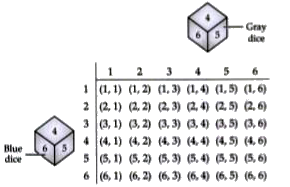Two dice are numbered 1,2,3,4,5,6 and 1,1,2,2,3,3 respectively. They are thrown and the sum of the numbrees of them is noted. Find the probability of getting each sum from 2 to 9 separately.
Total number of all possible outcomes, i.e., T(E) = 36
(i)Number of favourable outcome when
Sum of numbers on two dice is 2, i.e., (1,1),(1,1),
∴ F(E)=2
⇒ P1(E)=F(E)T(E)=236=118
(ii) Number of favourable outcomes when
Sum of number on two dice is 3, i.e., (1,2),(1,2),(2,1),(2,1)
∴ F(E)=4
⇒ P2(E)=F(E)T(E)=436=19
(iii) Number of favourable outcomes when
Sum of number on two dice is 4, i.e., (1,3),(1,3),(2,2),(2,2),(3,1),(3,1).
∴ F(E)=6
⇒ P3(E)=F(E)T(E)=636=16
(iv) Number of favourable outcomes when
Sum of numbers on the dice is 5,i.e, (2,3),(2,3),(3,2),(3,2),(4,1),(4,1)
∴ F(E)=6
⇒ P4(E)=F(E)T(E)=636=16
(v) Number of favourable outcomes when
Sum of numbers on two dice is 6,i.e., (3,3),(3,3),(4,2),(4,2),(5,1),(5,1).
∴ F(E)=6
⇒ P5(E)=F(E)T(E)=636=16
(vi) Number of favourable outcomes when
Sum of numbers on two dice is 7, i.e, (4,3),(4,3),(6,1),(6,1),(5,2) ,(5,2)<br>therefore " "F(E) = 6<br> rArr " "P_(6 ) (E) = (F(E))/(T(E)) = (6)/(36) =(1)/(6)<br>(vii)Numberoffavourab≤outcomeswhen<br>Sumofνmbersontwodiceis8,i.e.,(5,3),(5,3),(6,2),(6,2).<br>therefore " "F(E) = 6<br> rArr " "P_(7 ) (E) = (F(E))/(T(E)) = (6)/(36) =(1)/(6)<br>(viii)Numberoffavourab≤outcoeswhen<br>Sumofνmberson⊥hdiceis9.i.e.,(6,3),(6,3)<br>therefore " "F(E) = 2<br>rArr " "P_(8)(E)=(F(E))/(T(E)) = (2)/(36) = (1)/(8)
Topper's Solved these Questions
- BOOK - NAGEEN PRAKASHANCHAPTER - PROBABILITYEXERCISE - Exercise29videos
PROBABILITY
- BOOK - NAGEEN PRAKASHANCHAPTER - PROBABILITYEXERCISE - Revision Exercise Very Short Answer/short Answer Questions16videos
PROBABILITY
- BOOK - NAGEEN PRAKASHANCHAPTER - PROBABILITYEXERCISE - Revision Exercise Very Short Answer/short Answer Questions16videos
PROBABILITY
- BOOK - NAGEEN PRAKASHANCHAPTER - POLYNOMIALSEXERCISE - Revision Exercise Long Answer Questions4videos
POLYNOMIALS
- BOOK - NAGEEN PRAKASHANCHAPTER - QUADRATIC EQUATIONSEXERCISE - Revision Exercise Long Answer Questions6videos
QUADRATIC EQUATIONS
Similar Questions
Two dice are numbered 1,2,3,4,5,6 and 1,1,2,2,3,3, resepectively. They are thrown and the sum of the number is noted. Find the probability of getting each sum from 2 to 9, seperately.
View SolutionTwo dice are thrown at a time and the sum of the numbers on them is 6. The probability of getting the number 4 on any one of them is
View Solution
Knowledge Check
- Question 1 - Select One
Two dice are thrown. If it is known that the sum of numbers on the dice was less than 6, the probability of getting a sum 3, is
A118B518C15D25 - Question 2 - Select One
Two dice are thrown, and numbers shown on each dice is noted. What is the probability that sum of number is 9?
A16B13C19D29 - Question 3 - Select One
Two dice are thrown simultaneously. The probability of getting the sum 2 or 8 or 12 is
A518B736C718D536
A dice is thrown twice and the sum of numbers apear to be 6. Find the probability of getting 4 on at least one throw.
View SolutionTwo dice are thrown together once. Find the probability of getting a sum of more than 9.
View SolutionTwo dice are thrown. If it is know that the sum of numbers on the dice was less than 6, the probability of getting a sum 3 is
View Solution
Two dice, one blue and one grey are thrown at the same time.
Find the probability of getting an even number as the sum.View SolutionTwo dice are thrown simultaneously and the outcomes are noted. Find the probability that:
sum of numbers on the two dice is 5.View Solution

